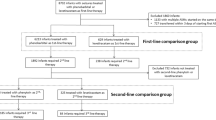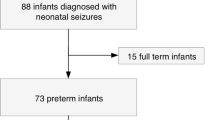Abstract
Objective:
Neonatal seizures are a common problem in the neonatal intensive care unit and are frequently treated with antiepileptic drugs. Limited data exist on current or changing antiepileptic drug use for seizures in the neonatal intensive care unit.We sought to describe trends of antiepileptic drug exposure in a large volume of US neonatal intensive care unit from 2005 to 2014 and we hypothesized increasing levetiracetam exposure over the 10-year study period.
Study Design:
Retrospective cohort study of infants from the Pediatrix Medical Group Clinical Data Warehouse, a large, multicenter, deidentified data set. Data were analyzed for trends in 2-year time periods. Our cohort included infants with a diagnosis of seizures who received an antiepileptic drug that were discharged from the neonatal intensive care unit from 1 January 2005 to 31 December 2014.
Results:
Among 778 395 infants from 341 facilities, we identified 9134 infants with a seizure diagnosis who received an antiepileptic drug. Phenobarbital was used in 98% of the cohort. From 2005–2006 to 2013–2014 phenobarbital exposure declined from 99 to 96% (P<0.001), phenytoin exposure decreased from 15 to 11% (P<0.001) and levetiracetam exposure increased 10-fold from 1.4 to 14% (P<0.001). Overall, <1% of infants were exposed to carbamazepine, lidocaine or topiramate.
Conclusions:
Infants with seizures were overwhelmingly exposed to phenobarbital, despite a significant increase in levetiracetam exposure. The use of phenytoin declined and has been surpassed by levetiracetam as the second most widely used antiepileptic in the neonatal intensive care unit. These changes in antiepileptic drug usage patterns have occurred in the absence of novel efficacy data in neonates.
This is a preview of subscription content, access via your institution
Access options
Subscribe to this journal
Receive 12 print issues and online access
$259.00 per year
only $21.58 per issue
Buy this article
- Purchase on Springer Link
- Instant access to full article PDF
Prices may be subject to local taxes which are calculated during checkout
Similar content being viewed by others
References
Volpe JJ. Neonatal seizures. In: Volpe JJ (ed). Neurology of the Newborn. Saunders/Elsevier: Philadelphia, PA, USA, 2008, pp 203–244.
Martinos MM, Yoong M, Patil S, Chong WK, Mardari R, Chin RFM et al. Early developmental outcomes in children following convulsive status epilepticus: a longitudinal study. Epilepsia 2013; 54 (6): 1012–1019.
Uria-Avellanal C, Marlow N, Rennie JM . Outcome following neonatal seizures. Semin Fetal Neonatal Med 2013; 18 (4): 224–232.
Slaughter LA, Patel AD, Slaughter JL . Pharmacological treatment of neonatal seizures: a systematic review. J Child Neurol 2013; 28 (3): 351–364.
Department of Health and Human Services. Pediatric Postmarket Pharmacovigilance and Drug Utilization Review [Internet]. 2014 [cited 15 September 2016]. Available at: http://www.fda.gov/downloads/AdvisoryCommittees/CommitteesMeetingMaterials/PediatricAdvisoryCommittee/UCM386843.pdf.
Carmo KB, Barr P . Drug treatment of neonatal seizures by neonatologists and paediatric neurologists. J Paediatr Child Health 2005; 41 (7): 313–316.
Silverstein FS, Ferriero DM . Off-label use of antiepileptic drugs for the treatment of neonatal seizures. Pediatr Neurol 2008; 39 (2): 77–79.
Glass HC, Kan J, Bonifacio SL, Ferriero DM . Neonatal seizures: treatment practices among term and preterm infants. Pediatr Neurol 2012; 46 (2): 111–115.
Bartha AI, Shen J, Katz KH, Mischel RE, Yap KR, Ivacko JA et al. Neonatal seizures: multicenter variability in current treatment practices. Pediatr Neurol 2007; 37 (2): 85–90.
Glass HC, Shellhaas RA, Wusthoff CJ, Chang T, Abend NS, Chu CJ et al. Contemporary profile of seizures in neonates: a prospective cohort study. J Pediatr 2016; 174: 98–103.
Spitzer AR, Ellsbury DL, Handler D, Clark RH . The Pediatrix BabySteps Data Warehouse and the Pediatrix QualitySteps improvement project system—tools for ‘meaningful use’ in continuous quality improvement. Clin Perinatol 2010; 37 (1): 49–70.
Srinivasakumar P, Zempel J, Trivedi S, Wallendorf M, Rao R, Smith B et al. Treating EEG seizures in hypoxic ischemic encephalopathy: a randomized controlled trial. Pediatrics 2015; 136 (5): e1302–e1309.
Farwell JR, Lee YJ, Hirtz DG, Sulzbacher SI, Ellenberg JH, Nelson KB . Phenobarbital for febrile seizures—effects on intelligence and on seizure recurrence. N Engl J Med 1990; 322 (6): 364–369.
Sulzbacher S, Farwell JR, Temkin N, Lu AS, Hirtz DG . Late cognitive effects of early treatment with phenobarbital. Clin Pediatr (Phila) 1999; 38 (7): 387–394.
Maitre NL, Smolinsky C, Slaughter JC, Stark AR . Adverse neurodevelopmental outcomes after exposure to phenobarbital and levetiracetam for the treatment of neonatal seizures. J Perinatol 2013; 33 (11): 841–846.
Bittigau P, Sifringer M, Ikonomidou C . Antiepileptic drugs and apoptosis in the developing brain. Ann NY Acad Sci 2003; 993 (1): 103–114; discussion 123–124.
Forcelli PA, Janssen MJ, Vicini S, Gale K . Neonatal exposure to antiepileptic drugs disrupts striatal synaptic development. Ann Neurol 2012; 72 (3): 363–372.
Bittigau P, Sifringer M, Genz K, Reith E, Pospischil D, Govindarajalu S et al. Antiepileptic drugs and apoptotic neurodegeneration in the developing brain. Proc Natl Acad Sci USA 2002; 99 (23): 15089–15094.
Marek E, Kraft WK . Ethanol pharmacokinetics in neonates and infants. Curr Ther Res 2014; 76 (C): 90–97.
Committee on Drugs. Ethanol in liquid preparations intended for children. Pediatrics 1984; 73 (3): 405–407.
Committee on Fetus and Newborn and Committee on Drugs. Benzyl alcohol: toxic agent in neonatal units. Pediatrics 1983; 72 (3): 356–358.
Harden CL, Meador KJ, Pennell PB, Hauser WA, Gronseth GS, French JA et al. Practice parameter update: management issues for women with epilepsy—focus on pregnancy (an evidence-based review): teratogenesis and perinatal outcomes: report of the Quality Standards Subcommittee and Therapeutics and Technology Assessment Subcommittee of the American Academy of Neurology and American Epilepsy Society. Neurology 2009; 73 (2): 133–141.
Meador KJ, Loring DW . Developmental effects of antiepileptic drugs and the need for improved regulations. Neurology 2016; 86 (3): 297–306.
Reinisch JM, Sanders SA, Mortensen EL, Rubin DB . In utero exposure to phenobarbital and intelligence deficits in adult men. JAMA 1995; 274 (19): 1518–1525.
Thorp JA, O'Connor M, Jones AM, Hoffman EL, Belden B . Does perinatal phenobarbital exposure affect developmental outcome at age 2? Am J Perinatol 1999; 16 (2): 51–60.
Thorp JA, O'Connor M, Belden B, Etzenhouser J, Hoffman EL, Jones PG . Effects of phenobarbital and multiple-dose corticosteroids on developmental outcome at age 7 years. Obstet Gynecol 2003; 101 (2): 363–373.
Khan O, Chang E, Cipriani C, Wright C, Crisp E, Kirmani B . Use of intravenous levetiracetam for management of acute seizures in neonates. Pediatr Neurol 2011; 44 (4): 265–269.
Khan O, Cipriani C, Wright C, Crisp E, Kirmani B . Role of intravenous levetiracetam for acute seizure management in preterm neonates. Pediatr Neurol 2013; 49 (5): 340–343.
İşgüder R, Güzel O, Ağın H, Yılmaz Ü, Akarcan SE, Celik T et al. Efficacy and safety of IV levetiracetam in children with acute repetitive seizures. Pediatr Neurol 2014; 51 (5): 688–695.
Tekgül H, Gencpinar P, Çavuşoğlu D, Dündar NO . The efficacy, tolerability and safety of levetiracetam therapy in a pediatric population. Seizure 2016; 36: 16–21.
Arzimanoglou A, Lösch C, Garate P, Bentz J . Safety of levetiracetam among infants younger than 12 months—results from a European multicenter observational study. Eur J Paediatr Neurol 2016; 20 (3): 368–375.
Kim J, Kondratyev A, Gale K . Antiepileptic drug-induced neuronal cell death in the immature brain: effects of carbamazepine, topiramate, and levetiracetam as monotherapy versus polytherapy. J Pharmacol Exp Ther 2007; 323 (1): 165–173.
Kim J-S, Kondratyev A, Tomita Y, Gale K . Neurodevelopmental impact of antiepileptic drugs and seizures in the immature brain. Epilepsia 2007; 48 (Suppl 5): 19–26.
Brown L, Gutherz S, Kulick C, Soper C, Kondratyev A, Forcelli PA . Profile of retigabine-induced neuronal apoptosis in the developing rat brain. Epilepsia 2016; 57 (4): 660–670.
Shallcross R, Bromley RL, Irwin B, Bonnett LJ, Morrow J, Baker GA et al. Child development following in utero exposure: levetiracetam vs sodium valproate. Neurology 2011; 76 (4): 383–389.
Shallcross R, Bromley RL, Cheyne CP, Garcia-Fiñana M, Irwin B, Morrow J et al. In utero exposure to levetiracetam vs valproate: development and language at 3 years of age. Neurology 2014; 82 (3): 213–221.
Hanson JW, Smith DW . The fetal hydantoin syndrome. J Pediatr 1975; 87 (2): 285–290.
Vanoverloop D, Schnell RR, Harvey EA, Holmes LB . The effects of prenatal exposure to phenytoin and other anticonvulsants on intellectual function at 4 to 8 years of age. Neurotoxicol Teratol 1992; 14 (5): 329–335.
Scolnik D, Nulman I, Rovet J, Gladstone D, Czuchta D, Gardner HA et al. Neurodevelopment of children exposed in utero to phenytoin and carbamazepine monotherapy. JAMA 1994; 271 (10): 767–770.
Painter MJ, Scher MS, Stein AD, Armatti S, Wang Z, Gardiner JC et al. Phenobarbital compared with phenytoin for the treatment of neonatal seizures. N Engl J Med 1999; 341 (7): 485–489.
Vento M, de Vries LS, Alberola A, Blennow M, Steggerda S, Greisen G et al. Approach to seizures in the neonatal period: a European perspective. Acta Paediatr 2010; 99 (4): 497–501.
Acknowledgements
Drs Bennett and Tolia had full access to all of the data in the study and take responsibility for the integrity of the data and the accuracy of the data analysis.
Author contributions
Dr K. Ahmad conceptualized and designed the study, analyzed and interpreted the data, drafted the initial manuscript and approved the final manuscript as submitted.
Drs Desai, Clark and Tolia conceptualized and designed the study, analyzed and interpreted the data, critically reviewed and revised the manuscript and approved the final manuscript as written.
Dr Bennett carried out the data analyses, critically reviewed and revised the manuscript and approved the final manuscript as written.
Drs S. Ahmad and Ng designed the study, analyzed and interpreted the data, critically reviewed and revised the manuscript and approved the final manuscript as written.
Author information
Authors and Affiliations
Corresponding author
Ethics declarations
Competing interests
Y-T Ng is on the speakers’ bureau for Upsher-Smith Pharmaceuticals, UBC Pharma, Lundbeck Pharmaceuticals, Eisai Pharmaceuticals, Cyberonics, Sunovion Pharmaceuticals, Supernus Pharmaceuticals, Zogenix Pharmaceuticals, has been a consultant for Mallinckrodt Pharmaceuticals and Eisai Pharmaceuticals and is an associate editor for Pediatric Neurology. VT has been a consultant for Chiesi USA. The other authors declare no conflict of interest.
Rights and permissions
About this article
Cite this article
Ahmad, K., Desai, S., Bennett, M. et al. Changing antiepileptic drug use for seizures in US neonatal intensive care units from 2005 to 2014. J Perinatol 37, 296–300 (2017). https://doi.org/10.1038/jp.2016.206
Received:
Revised:
Accepted:
Published:
Issue Date:
DOI: https://doi.org/10.1038/jp.2016.206
This article is cited by
-
Association between anti-seizure medication and outcomes in infants
Journal of Perinatology (2022)
-
Novel Therapeutics for Neonatal Seizures
Neurotherapeutics (2021)
-
Practice variation in anti-epileptic drug use for neonatal hypoxic-ischemic encephalopathy among regional NICUs
BMC Pediatrics (2019)
-
Status Epilepticus in the Neonate: Updates in Treatment Strategies
Current Treatment Options in Neurology (2019)
-
Neurodevelopmental outcomes at 9–14 months gestational age after treatment of neonatal seizures due to brain injury
Child's Nervous System (2019)



